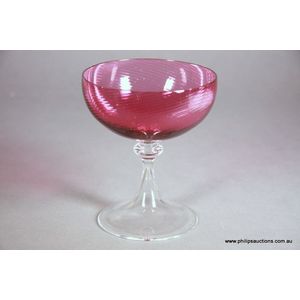Amethyst and Clear Glass Art Deco Comport by Schneider
You must be a subscriber, and be logged in to view price and dealer details.
Subscribe Now to view actual auction price for this item
When you subscribe, you have the option of setting the currency in which to display prices to $Au, $US, $NZ or Stg.
- Art Deco Period - The Art Deco period was a cultural movement that emerged in the 1920s and 1930s, and was characterized by its emphasis on modernism, luxury, and elegance. The name "Art Deco" comes from the Exposition Internationale des Arts Décoratifs et Industriels Modernes, a large exhibition held in Paris in 1925 that showcased the latest trends in decorative arts.
Art Deco was a reaction against the ornate and elaborate styles of the previous era, and reflected a new modern sensibility. It was characterized by streamlined, geometric shapes, bright colours, and the use of new materials such as chrome, glass, and Bakelite. Art Deco designers sought to create a sense of luxury and sophistication, often incorporating expensive materials such as ivory, marble, and rare woods.
Art Deco had a significant impact on a wide range of artistic fields, including architecture, fashion, graphic design, and interior design. Some of the most iconic examples of Art Deco architecture include the Empire State Building in New York City, the Hoover Building in London, and the Palais de Chaillot in Paris.
The Art Deco period came to an end in the 1940s, as World War II and changing cultural trends led to a shift in artistic styles. However, Art Deco remains an important influence on design and art, and continues to be celebrated for its modernist sensibility and glamorous aesthetic. - Circa - A Latin term meaning 'about', often used in the antique trade to give an approximate date for the piece, usually considered to be five years on either side of the circa year. Thus, circa 1900 means the piece was made about 1900, probably between 1895 and 1905. The expression is sometimes abbreviated to c.1900.
- Comport - A comport is a type of decorative serving dish or bowl, typically used for desserts, fruits or other sweet treats. The comport is usually made from glass, silver or porcelain, which are materials known for their elegance and durability. They are often beautifully designed and decorated, and can be used as an elegant and decorative centerpiece for a table or dining room. They are also widely used as a decorative piece on the mantelpiece, sideboard, or other areas of the house.
This item has been included into following indexes:
- centrepieces and comports - glass objects 247
-
Schneider / Le Verre Francais (France)
- glass makers 134
- lamps and lighting 313
Visually similar items

A glass comport by Le Verre Francais, France, mid 1920s, a low bowl with a finely textured ground in modulating pinks and cobalt etched and enamelled in the 'Garance' pattern with trailing pendants in raspberry to purple, a polished pontil, and etched Le v

An Orrefors glass bowl with vertical fluting. 23 cm wide. Together with a Lalique glass vase of flared form, with a number of large chips. 28 cm high

A set of six ruby glass Murano champagne Coupes, the glasses each with a fine spiral decor with a clear hollow knopped stem and a spreading foot; originally purchased through Georges. Height 12 cm

Vintage cut crystal table lamp 25 cm high
